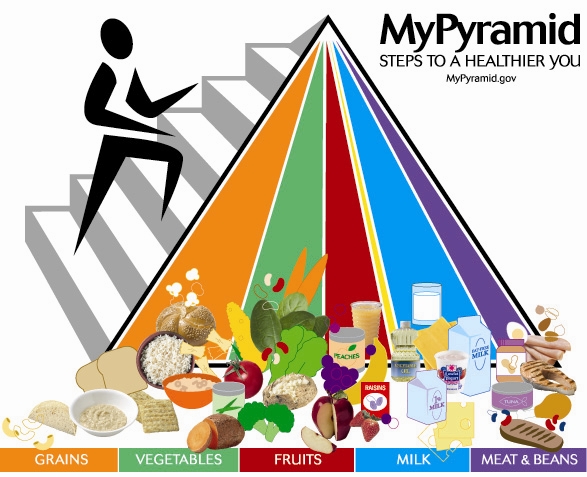MyPyramid
In 2005 the U.S Department of Agriculture (USDA) released a food pyramid called MyPyramid, which was designed to educate people about the 2005 Dietary Guidelines for Americans. It replaced the previous food guide pyramid that was introduced in 1992. These guidelines were developed jointly by the USDA and the Department of Health and Human services (HHS). The dietary guidelines are revised every five years by both departments. (Currently, there are new guidelines in place, and the government have decided to drop the pyramid shaped illustration to replace it with a plate model called MyPlate.)
The design of MyPyramid consists of vertical colored stripes. Each color has a different size, suggesting the amount of food that you should choose from each group. The figure on the stairs is there to remind you of the importance of physical activity.
So what type of food does each color stand for? Let’s find out what the color stripes represent in MyPyramid, and what the best choices are for each food group within the USDA food pyramid.

Image: MyPyramid, U.S Department of Agriculture
MyPyramid – Grains
- MyPyramid recommends that at least 50% of the grains should be whole grain.
- Eat at least 3 ounces of whole grain breads, crackers, cereals, crackers, rice or pasta everyday.
1 ounce= 1 slice of bread, or 1 cup of breakfast cereal
1 ounce= 1/2 cup of cooked rice, or cereal, or pasta.
There are two types of grains: whole grains and refined grains. Refined grains have been milled to gain finer texture and improve their shelf life. The problem with this process is that all fiber, iron and most of the vitamin B, have been removed. After this process the iron and vitamin B are often added back (enriched). The fiber is not added back though, and fiber is very important for the health of the digestive system and for lowering cholesterol.
MyPyramid – Vegetables
- MyPyramid recommends that you should vary your veggies.
- Eat more of the dark green and orange veggies and more of the dry beans and peas.
- The amount of vegetables you need to eat depends on your age, sex and level of physical activity. For adults 2 1/2 cups of vegetables and 2 cups of fruit per day is recommended for a reference of 2000 calorie intake, with higher or lower amounts depending on the calorie level.
1 cup=1 cup of raw/cooked vegetables, or vegetable juice.
1 cup=2 cups of raw leafy greens.
Your body has the capability to store some vitamins, but this is not the case with vitamin B and C. Vitamin B and C can not be stored in your body. Therefore, it is very important to get these vitamins everyday from food. The best source for vitamin B and C is vegetables. This is why you need to eat vegetables everyday.
MyPyramid – Fruits
- MyPyramid recommends that you should eat a variety of fruits, but go easy on the fruit juice. Chose fresh, frozen, canned or dried fruit.
- The amount of fruits you need to eat depends on you age, sex and level of physical activity. For adults 2 cups of fruit and 2 1/2 cups of vegetables per day is recommended for a reference of 2000 calorie intake, with higher or lower amounts depending on the calorie level.
1 cup= 1 cup of fruit, or 100% fruit juice, or 1/2 cup of dried fruit
Fruit contains many important vitamins and minerals that most people don’t generally get in their regular diet. Fruit is a good source of fiber and contains very little fat. Eat at least two-three fruits a day, and don’t forget the vegetables. Fewer than 15 percent of the two million American elementary school-aged children, eat the recommended five or more daily servings of fruits and vegetables.
Fruit juice contains many vitamins and nutrients that are good for you, but it’s healthier if you eat fresh fruit instead of drinking juice, since you get more of the fibers and less of the sugar. When you drink ½ cup of apple juice, it’s the same as eating an entire apple but the difference is that the apple has all the fiber that fills you up. This means that we drink more and intake more sugar than is healthy. The sugar intake of one glass of juice can equal that of a soft drink and sometimes the calories can be even higher. One glass of juice every morning is OK, just don’t over do it.
MyPyramid – Oils
- MyPyramid recommends that most of your fat should come from fish, nuts and vegetable oils.
- Keep total fat intake between 20-35% of calories with most fats from polyunsaturated and monounsaturated fatty acids.
Oils from plant sources (vegetable and nut oils) are better for your health since they do not contain any cholesterol. You should limit solid fats like butter and margarine. Solid fats come from animals and are solid at room temperature. Solid fats are considered a contributor to cardiovascular disease, a leading cause of death in the U.S.
MyPyramid – Milk, Yogurt and Cheese
- MyPyramid recommends 3 cups per day of fat-free or low-fat milk, or milk products for adults.
- Children 2-8 years old should consume 2 cups per day of fat-free or low-fat milk.
- Milk, yogurt and cheese are all rich in calcium.
- Choose lactose-free product or other calcium sources if you can’t consume milk.
Calcium is important for developing bones, especially when you grow. Milk, yogurt and cheese are all rich in calcium. Be aware though that cream cheese, cream and butter are not rich in calcium. You should also be aware of the extra calories that contains in the sweetened milk products that you choose. If you can’t drink milk, try lactose free products or other calcium sources.
MyPyramid – Meat, Poultry, Fish, Dry Beans, Eggs and Nuts
- MyPyramid recommends that you should choose low-fat or lean meats and poultry.
- Bake it, broil it or grill it.
- Eat more fish, beans, peas, nuts and seeds. They contain healthier unsaturated fats.
Instead of just eating red meat, vary your choices with more fish, beans, peas, nuts and seeds. They all contain good, healthier unsaturated fats. Salmon, trout and herring are high in omega-3 fatty acids, which are good for your health. Flax and walnuts are excellent sources of essential fatty acids. Sunflower seeds, almonds, hazelnuts are good sources of vitamin E. 2 servings or fish per week (8 ounces total) may reduce the risk of mortality from coronary heart disease, according to studies.
MyPyramid – Physical Activity
The figure on the stairs is there to remind you of the importance of physical activity.
- MyPyramid recommends that adults should engage in physical activity (above usual activity) for at least 30 minutes every day, or most days.
- Children and teenagers should be physically active for at least 60 minutes every day, or most days.

 Facebook
Facebook  Twitter
Twitter  RSS
RSS







